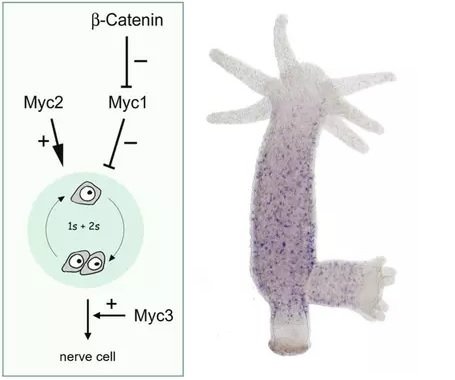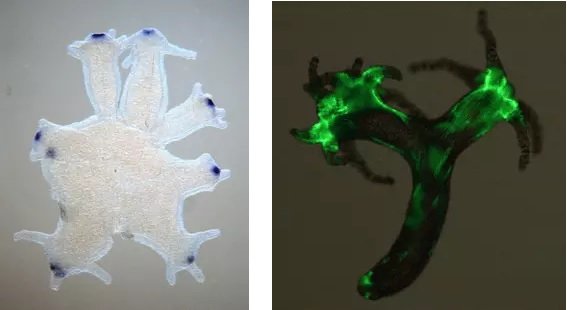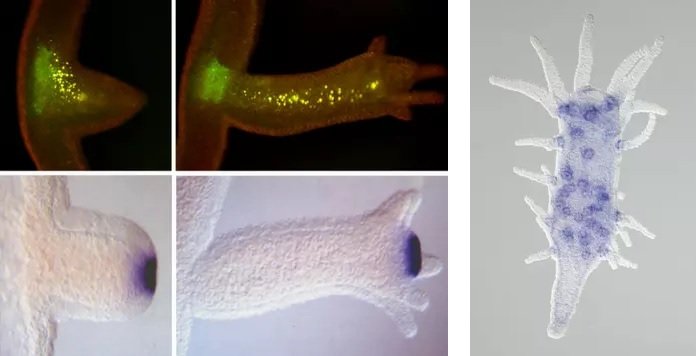Stem cells
Hydra’s simple body is composed of three independent cell lineages, all of which contain large pools of either epithelial or small, set aside adult stem cells. They represent ancestral stem cell types present when animal multicellularity evolved. Of particular interest are interstitial stem cells. These stem cells give rise to somatic cell types such as neurons, stinging cells and gland cells and thereby control most of the polyp’s behavior, as well as to both types of gametes. They exhibit a stochastic mode of decision making, whose molecular control mechanisms are unknown. We are interested in characterizing regulatory factors in order to gain a molecular understanding of the homeostatic balance of cell types during growth, regeneration, and sex-induced ageing. Our recent work has focused on Myc proteins, their structural and functional conservation, and their biochemical properties in comparison to mammalian c-Myc. Myc1 and Myc2 act in self renewal in interstitial stem cell, Myc3 seems to be involved in neurogenesis. In addition, we study the role of Wnt/beta-Catenin signaling in stem cell decision making. The accompanying scheme illustrates our current working hypothesis, which we have started to test in detail by functional interference.

Regeneration
Hydra is one of the classic models for regeneration research exhibiting an unparalleled capacity to rebuild lost body parts. Hydra regeneration is a result of exceptional phenotypic and molecular plasticity of the remaining tissue. An extreme case of regeneration is re-aggregation of suspensions of dissociated cells and the following self-organization into intact polyps within days. We were able to show that activation of the Wnt/beta-Catenin pathway is a hallmark of regeneration in Hydra, and this pathway seems to be required in regeneration responses throughout the animal kingdom. The action of Wnt/beta-Catenin signaling is complex, starts minutes after tissue loss, and is poorly understood. There are proposed functions during initial wound healing phase, during the following molecular patterning phase, as well as in the final differentiation of the newly forming structures. We investigate the role of canonical and non-canonical Wnt signaling pathways during Hydra regeneration and re-aggregation at cellular and molecular levels.

Axial patterning
Under conditions of regular asexual growth, adult Hydra polyps exhibit astonishing features usually found in animal embryos. All tissues are in a state of continuous replacement and movement. Small new polyps constantly develop by lateral budding. Polyps can also form de novo by re-aggregation of cell suspensions. We are interested to understand the cellular mechanisms involved in creating the 3-dimensional shape of polyp bodies and the underlying molecular patterning systems. Positional information is under control of an oral head organizer and a second signaling center located aborally in the foot. The head organizer is the major inductive signaling center and the equivalent of blastoporal organizers of higher animal gastrula stages, Wnt/beta-Catenin signaling has been demonstrated to represent the key element in the head organizer with axis inducing capacity upon transplantation to ectopic positions. Wnt/beta-Catenin signaling also activates non-canonical Wnt signaling at specific positions in the head and the lower body column, which then causes evagination of tentacles and buds, respectively. In addition, Wnt-interacting, secreted proteins of the sFRP family are activated in the aboral signaling center. Currently, we try to understand in more detail the interactions between oral and aboral signaling and their combined action in setting up axial positional values in newly forming buds, aggregates and regenerating polyps.

Members of the Hydra work group are:
Bert Hobmayer (head)
Birgit Lengerer (PostDoc)
Marion Lechable (PhD student)
Moses Kitilit Kibet (PhD student)
Matthias Achrainer (master student)
Sabina Schönberger (master student)
Kevin Grüner (master student)
Natalie Kolb (animal culture)
